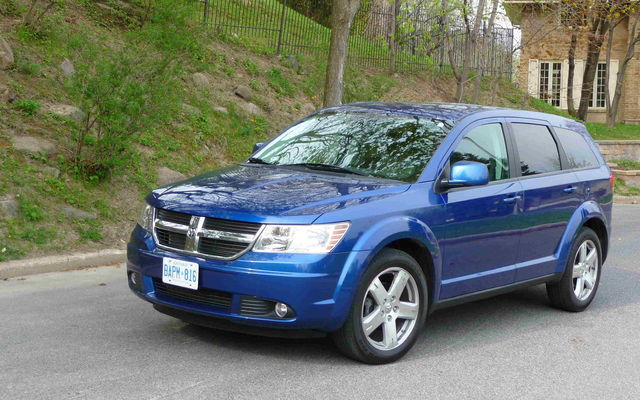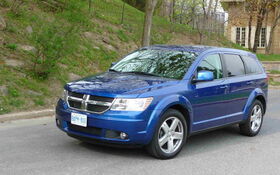The 2009 Dodge Journey, a nice idea, but...
Back in 2007 when they unveiled the Journey at the Frankfurt Auto Show, Chrysler had high hopes for the model, which was supposed to garner as much attention as the MagicWagon minivan did in the early 80s. People even went as far as saying that the Journey was going to create a whole new category, thus allowing Chrysler to get a leg up on the market.
I don’t know what the Chrysler management team was putting in their coffee back then, but it’s now clear that the Journey didn’t exactly create the stir that was expected. What the company executives didn’t realize at the time was that there were already similar vehicles out on the market, such as the Mazda 5 and even the Taurus X. Sure, the Journey’s done well enough for itself, but it certainly fell short of the revolution that was expected.
And here’s why: this Dodge does a good job, but no better than several other models on the market. Take the Mazda CX 7 for example; it’s basically the same size as the Journey, but is clearly more of a pleasure to drive (and the fact that it doesn’t have a third row of seats doesn’t seem to detract from its appeal). That being said, I’m not suggesting that the Journey doesn’t have its strong points. Quite the opposite, in fact! It just doesn’t seem to have that little something extra to catch people’s attention.
A little too moderate
While this car has a well-balanced and rather elegant silhouette, Chrysler’s days as a bold designer are over, or at least they seem to be in the case of the new Journey. Not even the cross-shaped chrome grille added any spice to the vehicle we test drove. On the upside, it did have a magnificent blue paint job. I thought the back section of the vehicle was quite well designed, with well-integrated tail lights and a gently curved rear window. A job well done with the side window design as well.
Despite these various pros, the Journey’s exterior is still a little too generic. Thankfully, they did a pretty good job on the interior, adding a few original features such as the greenish lighting on the controls and the textured metal center console which spruces up what would otherwise have been a pretty plain dashboard. Speaking of details, the Journey is equipped with two glove compartments, one on top of the other, which are able to keep drinks cool (notice I didn’t use the word “cold” because that would have been a lie!).
Several of my colleagues pointed out the very poor quality of the fit and trim. With regard to the model I test drove, the quality of the materials and the fit/finish were both decent. The driving position is good and the foot rest is decent too. However, getting into the car isn’t the easiest thing to do because you really have to take a big step up. As for the second row of seats, the bench seat is firm and the available space is just barely sufficient. If Chrysler’s marketing people think that the third row of seats is a solid selling point, they should advise their sales representatives to do everything in their power to keep people from sitting back there, lest they see their potential client have a change of heart. As with all vehicles of this type, the trunk space is rather modest when all seat rows are being used, but becomes much more generous when in five-passenger mode.
6X6
The model we test drove was equipped with a 235hp 3.5 litre V6 engine and a six-speed automatic transmission. That’s the most powerful engine type available for this vehicle, which was also equipped with AWD. By the way, I should mention that the base model has a 173hp 2.4 litre four-cylinder engine and a 4-speed automatic transmission. This model is just fine for people who drive alone or with one other person and don’t bring much with them in the car. However, if the car is weighed down too much, you may find it takes quite a while to get from A to B.
Though the V6 is a decent engine and the six-speed manumatic transmission does a good job, its fuel consumption is pretty high. I put up an average of about 14.1 litres/100km, which is a lot for this vehicle type and engine size. I should point out that the Journey we test drove had 19-inch Kumho Solus tires. It made me think that Goodyear tires, which were once everywhere on the North American market and have had their share of criticism, were practically Formula 1 tires compared to the Kumho tires.
Decent driving
To borrow a well-used expression, you could say that the handling and performance of the Journey “do the trick.” In fact, at normal speeds, it offers decent handling; there is some noticeable roll, but on the whole it’s pretty well-controlled. If you put your foot down on the accelerator a little more, take the corners a little harder and do some sudden breaking, you’ll soon discover that its platform (a longer and wider version of the Sebring/Avenger platform) quickly reaches its limits. It’s a better idea to just take your time, listen to the reasonably good stereo system and grab a cool drink from the glove compartment, while your passengers in the back watch a movie on a headliner-mounted screen and enjoy their own air-conditioning controls.
The main problem with the Journey, apart from the high fuel consumption, is actually a matter of perception. With a base price of $20,000, the Journey is an attractive buy, but it is hindered by a limited engine type and certain equipment shortcomings (despite having standard air-conditioning). Even if you opt for the higher-end models such as the SRT and R/T, there are still other rival models out there that are a better deal.
Despite all the downsides I’ve mentioned, the Journey still has a lot going for it. And of course there’s the feeling of uncertainty about the future that is influencing a lot of people these days, even though there really is no need since the automaker is now out of the bankruptcy court.












